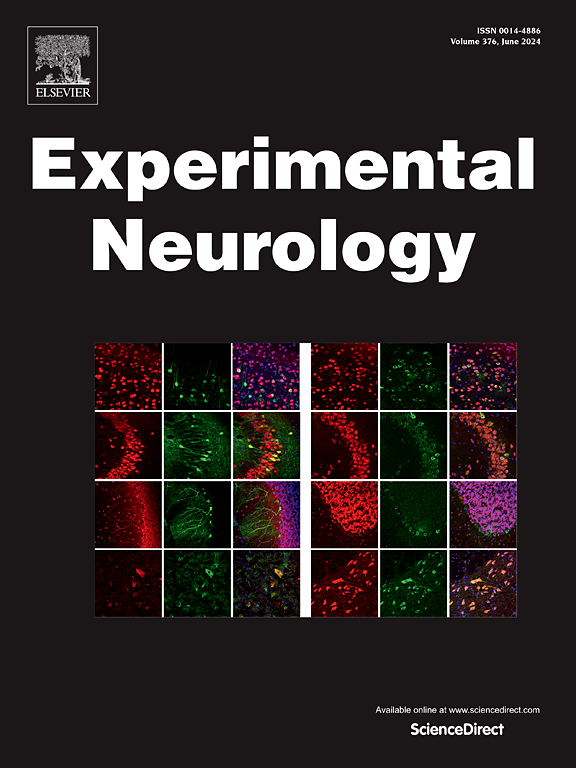Nucleophosmin 1 overexpression enhances neuroprotection by attenuating cellular stress in traumatic brain injury
IF 4.2
2区 医学
Q1 NEUROSCIENCES
引用次数: 0
Abstract
Background
Traumatic Brain Injury (TBI) is a multifaceted injury that can cause a wide range of symptoms and impairments, leading to significant effects on brain function. Nucleophosmin 1 (NPM1), a versatile phosphoprotein located in the nucleolus, is being recognized as a possible controller of cellular stress reactions and could be important in reducing neuro dysfunction caused by TBI. However the critical roles of NPM1 in cellular stress in TBI remains unclear.
Methods
We employed a control cortical impact mouse model and a scratch-induced primary neuronal culture model. Hematoxylin and eosin staining was used to evaluate tissue damage and cellular changes, with NPM1 expression in the cortical area assessed through immunofluorescence staining and Western blot analysis. Neuronal morphology was assessed using Nissl staining. Behavioral assessments were performed to evaluate the impact of NPM1 overexpression on neurobehavioral results in TBI mice. Mitochondrial function was assessed using an Extracellular Flux Analyzer.
Results
Following TBI, an increase in NPM1 expression was observed, with a peak at 72 h post-injury. Increased levels of NPM1 resulted in decreased neuronal cell death, as shown by Nissl staining, and lower levels of Caspase 8, APE1, H2AX, and 8-OHDG expression, indicating a reduction in DNA damage. NPM1 overexpression also resulted in improved neurobehavioral outcomes, characterized by decreased neurological deficits and enhanced motor function post-TBI. Additionally, in vitro, scratch-induction experiments revealed that NPM1 overexpression mitigated mitochondrial damage, as evidenced by the downregulation of P53, BCL2, and Cyto C expression levels and improvements in mitochondrial respiratory function.
Conclusion
These findings suggest NPM1 as a promising target for developing interventions to alleviate TBI-related cellular stress and promote neuronal survival.
核ophosmin 1的过表达可通过减轻创伤性脑损伤中的细胞应激增强神经保护作用。
背景:创伤性脑损伤(TBI)是一种多方面的损伤,可引起多种症状和损伤,从而对脑功能产生重大影响。Nucleophosmin 1(NPM1)是一种位于核仁中的多功能磷蛋白,被认为可能是细胞应激反应的控制者,在减轻创伤性脑损伤引起的神经功能紊乱方面可能具有重要作用。然而,NPM1在创伤性脑损伤的细胞应激反应中的关键作用仍不清楚:我们采用了对照皮质撞击小鼠模型和划痕诱导的原代神经元培养模型。血红素和伊红染色用于评估组织损伤和细胞变化,通过免疫荧光染色和 Western 印迹分析评估 NPM1 在皮质区域的表达。神经元形态通过 Nissl 染色进行评估。进行行为评估以评价 NPM1 过表达对创伤性脑损伤小鼠神经行为结果的影响。使用细胞外通量分析仪评估线粒体功能:结果:创伤性脑损伤后,观察到 NPM1 表达增加,并在伤后 72 小时达到峰值。NPM1 水平的增加导致神经元细胞死亡减少(如 Nissl 染色所示),Caspase 8、APE1、H2AX 和 8-OHDG 表达水平降低,表明 DNA 损伤减少。过表达 NPM1 还能改善神经行为结果,其特征是创伤后神经功能缺损减少,运动功能增强。此外,体外划痕诱导实验显示,过表达 NPM1 可减轻线粒体损伤,P53、BCL2 和 Cyto C 表达水平的下调以及线粒体呼吸功能的改善都证明了这一点:这些研究结果表明,NPM1 是开发干预措施以减轻创伤性脑损伤相关细胞应激和促进神经元存活的一个很有前景的靶点。
本文章由计算机程序翻译,如有差异,请以英文原文为准。
求助全文
约1分钟内获得全文
求助全文
来源期刊

Experimental Neurology
医学-神经科学
CiteScore
10.10
自引率
3.80%
发文量
258
审稿时长
42 days
期刊介绍:
Experimental Neurology, a Journal of Neuroscience Research, publishes original research in neuroscience with a particular emphasis on novel findings in neural development, regeneration, plasticity and transplantation. The journal has focused on research concerning basic mechanisms underlying neurological disorders.
 求助内容:
求助内容: 应助结果提醒方式:
应助结果提醒方式:


